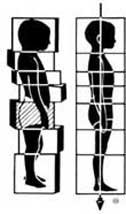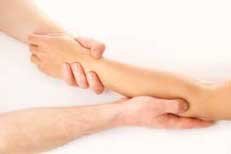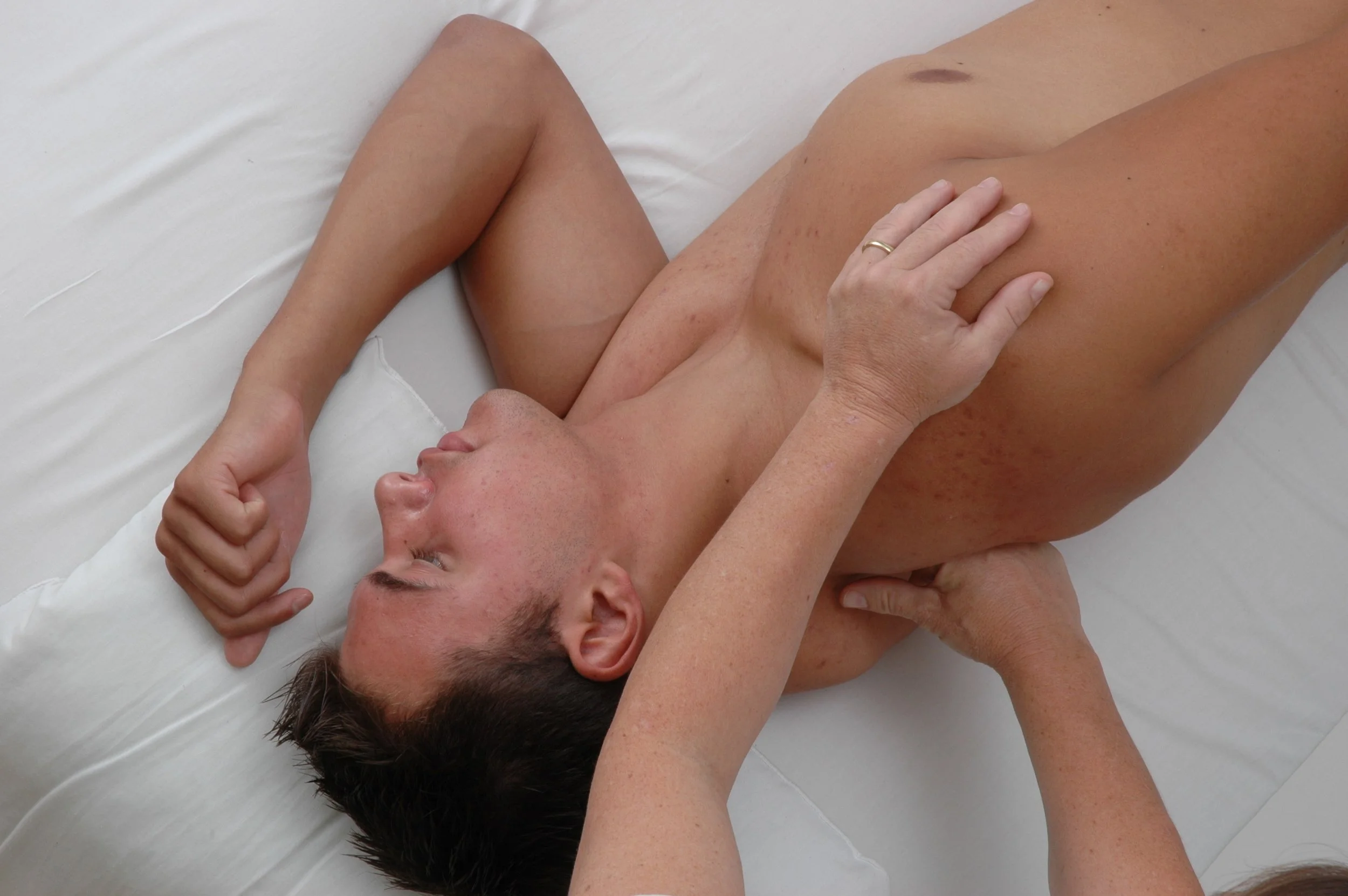Rolfing® Structural Integration
Since we experience life through our physical being, the more comfort and ease we experience in our bodies, the easier it is to live life fully and presently.
Rolfing® Structural Integration is an educational, hands-on therapy that releases restrictions in your body's fascia to improve skeletal alignment. Fascia is the connective tissue that suspends and holds everything in your body in place, therefore shaping and organizing your physical structure. The aim of Rolfing is to balance the tensions of the fascia in order to align your body, allowing you to receive better support from gravity. (See below for more about Fascia and Gravity.)
Traditionally, Rolfing is provided as a series of sessions, but the practitioners in our office usually provide more targeted sessions to respond to your body’s current needs.
What is Rolfing®?
Rolfing is offered by Holly Krebs, Risa Kearn, Kalen Ledbetter, and Cindi Thomas.
Holly and Risa are not currently taking new clients.
What is Fascia? How Does It Hold Me Together?
Fascia is a type of connective tissue. It is a continuous, strong, resilient net that covers and holds everything in your body in place–muscles, bones, organs, vessels, nerves. It is like a three-dimensional piece of fabric that creates the shape of your body and organizes the relationships of its parts.
The fascia interweaves with every muscle fiber and is continuous with the tendons that attach muscle to bone. Therefore, the fascia suspends the bones in place through tensile force, which then determines the alignment of your skeleton. Because fascia is continuous and pervasive, a hitch anywhere in the fabric of your fascia can and does affect overall alignment.
“Fascia is the organ of posture.”
Fascia is malleable and responds to the demands placed on it. It adapts to trauma, repetitive activities, habitual postures and movements, and the constant force of gravity. (See Gravity.) Because of fascia's adaptability and its continuity, the whole body changes its shape to reflect the way in which we use it
Fascia is always creating a balance in the body, but the question is whether the fascia's organization of the body is efficient. It might have organized well to get you through a sprained ankle, a broken arm, or the loss of a loved one, but perhaps has never released that pattern. It might have organized well for sitting in a chair all day, but a sustained, invariable posture places strains on our body that are not counterbalanced.
When fascia changes, it reorganizes the relationships of your body parts. While the reorganization in response to injury or repetitive activity may allow you to continue walking, sitting, breathing, thinking, it also creates an imbalance of the fascial tensions that support your structure, leading to less than ideal posture and skeletal alignment. How can we use fascia's malleability to improve our body's organization and, therefore, our comfort and flow of energy?
Ida Rolf on gravity
"[S]tructure is determined by the relation of the body to the gravitational field. . . . We can't change the gravitational field . . . What we can do is to change the way the parts of the body fit together into a whole which can transmit the gravitational field through that body in such a way that it enhances its energy field.”
"[T]he spine [is] a vital core that integrates the human with his gravity environment, poorly, well, or adequately, as the case may be." Dr. Rolf likens the spine to a tent pole "[I]f the tent pole is off-center, its weight will drag it down; if it is upright, its weight will balance and keep it upright." Ideally, "the spine distributes weight through balance."
“The gravitational field of the earth is easily the most potent physical influence in any human life. . . . Gravity is with us from the time of our conception to the moment of death. It is so all-pervading that we cannot sense it, for humans perceive sensory stimulation only as it varies. . . .We do not sense gravity, but we do adjust to it. We must.”
Excercises
Exercise: Note what feels unusual, if anything, the day of and days after a session. If you're so inclined, keep a journal of these observations, because it's easy to quickly acclimate to or ignore changes.
Exercise: Periodically check in with your internal experience throughout the day, especially at times when you're stressed, irritated, or tired. Can you identify places of physical tension that are supporting your mental tension? Release the physical tension by taking a few moments to breathe deeply and relax your body. Does this help defuse your emotional and psychological response? With repetition of this exercise, do you notice specific physical patterns associated with your mental patterns. For example, can you be irritated if your jaw isn't tense or if you aren't breathing shallowly? Ask yourself if you are willing to let go of both your physical and emotional tensions. If you aren't, just acknowledge the tension's presence and allow it to continue.
What Can You Expect and Learn from Rolfing
“When the body gets working appropriately, the force of gravity can flow through. Then, spontaneously, the body heals itself.”
Fascia's ability to change can be used to your advantage. Rolfing's primary aim is to change your fascia in order to reduce structural restrictions and to better balance and align your body in gravity. Better alignment provides the foundation for more ease in your body, less effortful and better posture, less pain, more freedom of movement, and less physical stress. These improvements can translate to less mental stress, more energy, and the ability to more easily adapt to life's challenges.
In response to your personal history, your body develops characteristic patterns of tension. Rolfing gives you the perspective to recognize these patterns and learn how to inhabit your body differently. By releasing the restrictions that shape your movement and posture patterns, you discover that, in fact, there were patterns. With this newfound physical freedom and mental perspective, you are opened to the possibilities of new movements and ways of being.
Client Participation – What Do I Need to Do?
The practitioner and client are partners in promoting and retaining positive changes. While the potential for your body to change lies partially in a Rolfer's hands, the realization of that potential also depends upon you.
The patterns of your posture and movement reflect physical adhesions and shortness in tissues, yet your brain, nervous system, joints, and muscle memory all play equally large roles in determining how you use your body. Therefore, the ways in which you explore and choose to use your body in and out of sessions can "re-wire" your physical patterns and habits. You are your own, constant therapist–day in and day out, 24-7–and it is beneficial to enter the process with a willingness to try new things in your body, in your life, and in the ways you interact with the world.
In sessions, the practitioner might ask you to bring awareness to an area, to breathe at specific times, to move, or even just imagine a movement in order to put you and your nervous system in touch with your body. We might ask you to move or walk in a familiar way and then try a change. This helps you learn how to move in and out of your familiar patterns and ways of being. This work of yours will encourage physical change from the inside while our efforts will encourage change from the outside.
During sessions
Discussions about your body's history of usage, injury, training, and repetitive activity; how you feel about your body; and how you currently use it will bring unconscious habits to your conscious awareness. This encourages you to explore why you do things the way you do, and how your patterns both support and hinder your movements. Conscious awareness promotes the ability to be different.
Outside of sessions
For every session that we spend opening your body to new possibilities, you will spend many hours learning how to use those possibilities. The more you use the sessions to become aware of your body's baseline habitual functioning and to experience new options of movement, the more you can play with your new ways of being. These hours of integration outside of sessions determine much about how you change. The Rolfing experience is a catalyst that you can choose how to use.
For a couple of days or more after a session, your body is in a malleable state. Muscular releases may occur, physical patterns may become obvious, "lightbulb" moments of physical or other understanding may happen, or you may find a new way to move. These enlightening moments are valuable, and efforts to retain these awarenesses help you integrate the Rolfing work you receive.
If the work also inspires you to explore the way you express yourself and interact with the world, you can encourage that exploration. It's helpful to give yourself the latitude to be different and ask your loved ones to give you support and be open to your changing. Additionally, giving yourself time after sessions and throughout the week to be self-reflective–relaxing, walking, meditating, contemplating–assists this process. (See Exercises .)
“We are looking for a way to evoke human potential . . . to establish greater physical and mental vitality.”
What is the 10-Series?
The Rolfing 10-Series is a holistic process that progressively addresses all parts of your body. The goal of these 10 sessions is to balance and align your structure in gravity. In an integrated structure, such as the body, everything is connected. To balance your body, the whole must be addressed. Each of the 10 sessions focuses on a targeted area of the body and has specific functional goals. The goals of the sessions build upon each other throughout the series. For example, the first session's goal is to improve the breath through freeing the rib cage, and a goal of session three is to better connect the rib cage to the support provided by the lower half of the body.
“Rolfing can be seen as “an approach to the personality through the myofascial collagen components of the physical body. . . . [P]sychological changes that appeared in Rolfed individuals . . . suggest that behavior on any level reflects directly the . . . physical structure.”
“We want to get [the client] into the place where gravity reinforces him and is a friend, a nourishing force.”
The body is very complicated both mechanically and neurologically; in order to change, each part requires dedicated attention. And because fascia is dense, thick, and pervasive, it changes slowly, requiring steady, regular attention. The Rolfing 10-series acknowledges this need for a progressive process, which allows you to change slowly and to gradually integrate those changes as you learn how to use your body differently.
If you seek relief from a specific complaint, the Rolfer will spend time not only on that particular area during appropriate sessions, but will also examine and address how the rest of the body is affecting, supporting, or encumbering an area of chronic discomfort. While the 10-series may or may not provide complete relief, Rolfing's holistic approach usually brings long-lasting, positive change. When the whole body supports a structural improvement, that change is more likely to be retained.
You can assist the Rolfing process considerably. The more interested you are in engaging with your body and exploring your physical sensations, the more effective and easier your changes can be.
What Happens After Receiving a Rolfing Session or the 10-Series?
Rolfing Structural Integration encourages exploration and awareness of your self. It changes your body's baseline structure and gives you access to more choice about how you use your body.
Your fascia and nervous system continue changing and learning in response to the Rolfing work and to the ways in which you explore your new physical options. After receiving some sessions, you may want to take a break from Rolfing for several months to integrate the changes. During this time, you and gravity are your therapists as you explore how to move and be. Your body uses this time to develop new patterns of movement and posture.
Once you receive some Rolfing sessions, it is an excellent time to explore a new physical activity that supports your structural alignment and encourages physical exploration. Yoga is an ideal complement to Rolfing–it strengthens postural muscles and loosens restrictions, both of which support good skeletal alignment. Other physical activities, such as dancing, swimming, Pilates, Tai Chi, and bicycling introduce you to new physical skills and strengthen your tissues. Remember, all activities encourage certain physical patterns. Approach your new activity with conscious awareness so you don't get stuck in that activity's patterns. Pursue a variety of activities.
Return to Rolfing as you need. Many clients receive monthly or quarterly “tune-up” sessions, and some do short series of appointments to unravel complicated patterns or to help with injury recovery.
What Do I Wear?
Rolfing practitioners work with their clients in underclothing. This allows the Rolfer to see the contours and movements of the body fully and to work with you in a variety of positions. For men, briefs, boxer-briefs, regular boxers, or workout shorts are all acceptable; for women, bra and underwear or a two-piece swimming suit work well. If you are not comfortable with these clothing options, we can work with you more fully clothed.
Dr. Ida Rolf's quotes are taken from Rolfing and Physical Reality and Rolfing: Reestablishing the Natural Alignment and Structural Integration of the Human Body for Vitality and Well-Being.









